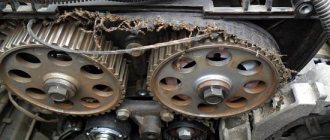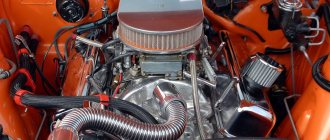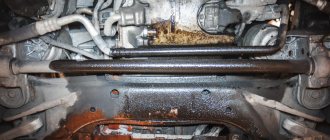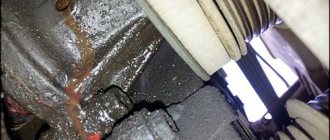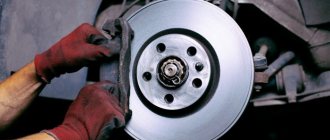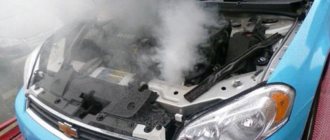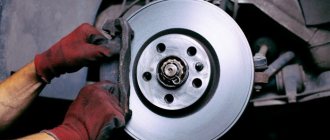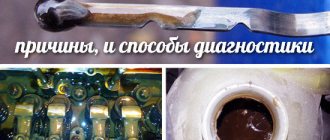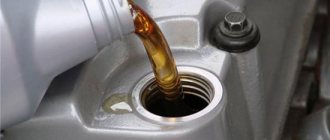Sometimes, while inspecting the level of antifreeze in the system, the driver observes a change in the color of the refrigerant. If you see bubbles, a brown tint, and traces of oil on the tank cap, then congratulations, you have unpleasant problems. Antifreeze got into the oil. The problem also has other signs, but it is important to know not only this, but also what the cause of the problem is.
When I encountered such a violation, the first thing that interested me was whether it was possible to drive a car. In general, if trouble does arise, the information presented in my review will be very useful.
The main signs indicating that oil has entered the antifreeze
The most important sign of the appearance of oil in antifreeze is a change in the color of the liquid. In addition, bubbles appear in the refrigerant. If traces of oil are clearly visible on the neck of the expansion tank, then we can say with confidence that oil has leaked into the antifreeze fluid. If these signs are not convincing, then there are other symptoms:
- the coolant level in the tank has decreased;
- white smoke began to appear from the exhaust pipe;
- The color of the oil on the dipstick has changed significantly.
Two of these indicators are checked using a special probe. If the leak is not visually observed, then the reasons may be completely different. Sometimes the presence of oil in antifreeze is indicated by the condition of the spark plugs. The elements will be moist and have a sweetish odor.
Condensation has appeared
If water enters the lubricating system, then the oil completely changes its properties. The oil will not be able to dissolve without a residue, but with prolonged mixing, an emulsion can form. This is the kind of liquid the driver detects on the dipstick. Even if the oil has just been changed, the water that gets in will completely change its properties.
Don't be afraid that there is a leak somewhere. Water in the cylinders may appear from the air. And that's a fact. If the ambient temperature has a large difference with the temperature of the metal parts of the engine, then condensation may settle on the cylinder walls. Typically, this phenomenon can be encountered in the fall or winter, when the car is parked on the street. Water condenses on the metal and flows into the crankcase, where it mixes with the oil. The result is foam.
In order to somehow overcome this problem, you need to warm up the engine thoroughly and for a long time in the winter. Then the water will simply evaporate. Experts also recommend insulating the engine to quickly warm it up in the morning.
Reasons for coolant getting into engine oil
Before we begin to study the question of how to diagnose a malfunction and what to do to fix it, let’s consider the main reasons for antifreeze getting into the engine oil. This will, to a certain extent, help us correctly localize the breakdown in order to make the right decision on how to minimize the consequences for the power unit.
In principle, there are few such reasons:
- loss of integrity of the gasket separating the two main parts of the motor: the upper (block head) and the lower (the block itself). In a particular case, in the event of such a malfunction, the coolant will not flow out at all, that is, if the antifreeze level drops, a visual inspection of engine parts and subsystems will be ineffective. We have already said that the line through which antifreeze circulates is closed, separate and sealed. But since the motor consists of two parts, and its internal geometry is quite complex, there is at least one large joint (between the BC and the cylinder head), which can be considered a potential source of depressurization of the cooling system. Initially, a moderately soft gasket is installed between these halves (made either from thin sheet metal or from paronite with reinforcement and a metal edging around the perimeter), which does not allow either mutual penetration of technical fluids or their leakage out. Damage to this gasket is one of the main reasons for depressurization of the cooling circuit, and in this case, antifreeze will enter the working cylinders - the responsibility of the engine oil. the reasons for damage to the gasket can be different, from burnout (due to the slightest inaccuracies when installing the gasket) to violation of the ideally flat geometry of the seat;
- the occurrence of defects in the block head. As a rule, such deformations occur mainly in the area directly adjacent to the lower part of the power unit, that is, to the cylinder block. The consequences of such defects are predictable - deterioration of the tightness of the seal to the seating planes of the gasket. At the same time, even without being damaged, it will gradually begin to leak coolant (due to its much lower viscosity than engine oil). In this case, there will definitely be no external signs of a leak, so if you find an antifreeze leak, you will definitely not be able to quickly localize the place where it is leaking. If the curvature of the seat is minimal, there will be very little leakage and the mixing of fluids will also be gradual. This is bad, because the consequences of such a mixture of oil and antifreeze will last much longer, and we will talk about them later. Such a malfunction can only be determined by troubleshooting, that is, after disassembling the cylinder head;
- Another reason why antifreeze gets into the oil is the occurrence of defects in the cylinder block body itself. These could be cracks located in areas of coolant circulation, which again occur when the engine overheats or as a result of a collision of the car with an obstacle. This malfunction is considered the most serious, since its identification will require dismantling the entire engine.
Is it possible to drive with oily antifreeze?
If signs of oil getting into the cooling system are detected, the car can be driven only to get home or the nearest service station. It is necessary to eliminate the identified malfunction as quickly as possible. Operating a car in which lubricant and antifreeze are mixed for a long time will lead to serious damage, so you need to act quickly to get out of the situation with minimal consequences and minimal expenditure of money.
To avoid such problems, if it is necessary to add antifreeze, you should use only the same liquid as has already been filled. It is necessary to monitor the technical condition of the car. If you find signs indicating that oil is entering the cooling system, you need to find the cause and eliminate it immediately. If you can’t do this yourself, you need to turn to specialists.
Consequences of oil contamination with antifreeze for the engine
The coolant is a mixture of alcohol and distilled water. If such liquid gets into the engine oil, it is quite obvious that the lubricating properties of the latter will deteriorate as a result of dilution with antifreeze. The longer this mixing lasts, the worse the MM will lubricate the rubbing parts of the power unit.
It is not difficult to predict that the consequences of antifreeze getting into the oil will be far from optimistic: accelerated wear of engine parts will lead to the need for premature engine overhaul, which is complex and expensive. If for owners of cars with high mileage and age, “capital maintenance” is, it’s fashionable to say, a routine operation, then the need to restore a fairly fresh engine can be a very unpleasant surprise for the car owner.
If there is a depressurization of the cooling system, in which coolant penetrates into the cylinders, and the driver did not notice this (which is quite likely), then with further operation of the car, quite soon clearly audible knocking noises will begin to be heard in the engine area. This is the result of wear on the crankshaft/camshaft bearings.
The mechanism for the occurrence of knocking is as follows:
If antifreeze begins to leak from the oil through the cylinders, the first to feel the deterioration in the lubrication properties of the MM are the liners, which are essentially slightly modified, highly loaded plain bearings. They are available both on the camshaft and on the crankshaft of the power unit. Poor quality lubrication will lead to the formation of scuffs on the inner surface of the liners, which will only increase over time. They are the source of bearing knocking.
If you disassemble the engine and remove the liners, you will find that the friction layer on their surface is practically absent, but there are quite deep scratches and burrs (bulges). Due to overheating, the color of the liner changes from gray to mottled brown.
If you continue to examine the surface of the bearings under a microscope, which provides a very high (thousand-fold) magnification, you will notice microscopic white balls with diameters of about 25-35 microns on the surface of the bearings. It is these particles that are responsible for the formation of scratches: at high speeds of rotation of the shafts they... Like a plow, they bite into the surface of the bearings, leaving grooves and burrs of appropriate sizes.
With such aggressive behavior, the friction layer’s chances of remaining unharmed tend to zero. You may ask, where did these balls come from, since at first they were not there? Let's figure it out.
According to spectrographic studies, these round abrasive particles consist of a mixture of sulfur, phosphorus, calcium and other elements. Although it is not a metal, the hardness of these particles is higher than that of the friction layer. So he is the one who suffers first.
Over time, the balls, which also experience heavy loads, become so compact that they become harder than the material used to make the liners. Then they attack the bearings themselves, destroying their surface.
Where did the particles come from? It turns out that it comes from additives contained in all modern oils. But the catalyst for their precipitation and grouping into large formations is antifreeze.
Plus, of course, high temperature. A verbal description of this process is not very informative, since we have little idea at what speed all these metamorphoses occur on a running engine, to what temperatures its rubbing parts heat up.
The second most important consequence of mixing oil and antifreeze in the engine is the formation of an emulsion, which is facilitated by the active mixing of these two liquids at high speeds. Why is this happening? As we already know, the coolant contains a considerable amount of water. And if oil is practically insoluble in water, then the same cannot be said about additives. This means that by partially dissolving in antifreeze, they reduce their concentration in the lubricating fluid. It is noteworthy that a minimum amount of coolant is required to start such a process.
Let us remember once again that all these processes occur at high temperatures. As they know in chemistry courses, thermal energy promotes the occurrence of various reactions between substances. That is why it does not take much time to form sufficiently strong compounds of phosphorus, sulfur, potassium, and zinc in the oil. The main condition is that antifreeze gets into the MM.
Mixing motor lubricant with engine coolant is a critical malfunction that requires immediate intervention and elimination. In other words, the car cannot be operated, only repaired. Although infrequent, this problem occurs on new and used cars. To avoid costly repairs, the car owner must clearly understand the procedure for his actions when oil is found in antifreeze.
What is the engine lubrication system?
This system, by reducing the frictional forces of the elements, increases the life expectancy of all components of the device. As an addition, oil removes excess heat that is generated during the operation of components or a specific element. In order to achieve the maximum positive effect from the lubrication system, it is important to fill in the engine oil that will fully correspond to the operating modes of the engine.
The main components that make up the engine lubrication system:
- Filter.
- Oil pump.
- The oil pan contains most of the oil.
- Hoses and supply tubes.
The system is perfectly sealed, so it will be problematic for other liquids to get there. This was achieved by installing many gaskets and seals.
When the engine starts, the oil pump starts working and gradually increases the pressure. Oil flows through the system, having previously passed through a cleaning filter. The fluid primarily lubricates the components where severe wear is possible - the crankshaft journal, camshafts and valves. After which it drains into the crankcase, where it hits the connecting rod and is scattered onto the cylinder walls. Next, the oil scraper rings clean the cylinders. The entire lubrication process is uninterrupted and lasts as long as the motor is running.
How to fix the problem?
There are several ways to deal with the problem. Some manipulations are very complex and to solve them you should contact a service station, while some are easy to do yourself. The solution to the problem can be as follows:
- A burnt gasket can be easily replaced. It is quite possible to do this at home. True, here you will have to remove the cylinder head and have a torque wrench on hand.
- Grind the block head. This is only available for minor deformations. If the cylinder head is seriously damaged, then it will have to be changed.
- Performing or replacing the cylinder block.
The two extreme operations cannot be performed with your own hands. This will require serious equipment. It’s better to hire a master for the job. It is important to remember that “self-medication” can lead to the real problem and other damage.
Cracks in the cylinder head and gasket failure
If an emulsion appears on the neck cover, then this phenomenon is often caused by a violation of the integrity of the cylinder head gasket. A breakdown occurs due to overheating or wear. But this can only be seen on old engines that have not been looked after. The main sign that the gasket is broken is unstable engine operation. You may notice that antifreeze is leaving the tank.
How to prevent a malfunction from occurring?
You can avoid breakdowns if you take into account tips and recommendations for using antifreeze. The very first rule is that you absolutely cannot add antifreeze to the tank if it is not compatible with the composition already used. It is imperative to follow all manufacturer’s recommendations regarding the materials used.
Masters advise regularly performing car maintenance work. You need to carefully monitor how the car behaves and what symptoms appear. When signs indicating a violation appear, it is necessary not to continue driving the car, but to begin repairs.
Since the repairs may require quite serious repairs, it is better to immediately contact knowledgeable people. Specialists will quickly find the leak and be able to determine the causes. The repair technicians will also be able to carry out repairs to a higher quality. The service station has the necessary equipment, and the room is suitable for repair work.
Condensate
This problem is faced by car owners who store them in the garage. The emulsion is also visible to those motorists whose car is parked in the yard. If the car spends the night outside every day, then during the rainy months moisture vapor will regularly enter the crankcase. They will then condense in the pipes and oil lines. Up to several grams of condensate can enter the motor at a time. This is enough for an emulsion to appear in the engine.
About the white coating on candles
If a white coating has formed on the spark plugs, the reasons may be different. First of all, this indicates problems with fuel quality. But if it is a rough white coating on the spark plugs, the reasons are due to overheating of the engine. Also, similar soot forms if:
- The spark plug is not suitable for this engine (by heat rating or other parameters).
- The inlet pipe is leaking. Here air will be taken in from outside.
- Poor ignition calibration.
- There are problems with the cooling system (for example, a faulty radiator).

